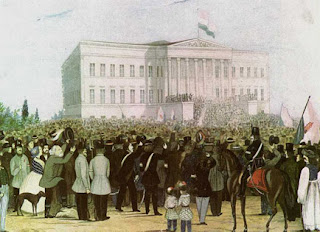On March 15th we commemorate the Hungarian Revolution and War of Independence of 1848-1849. This is also a public holiday in Hungary.

The Hungarian Revolution of 1848 was one of many revolutions that year and closely
linked to other revolutions of 1848 in the Habsburg areas. The revolution in the Kingdom of Hungary grew into a war for independence from Habsburg rule.
Many of its leaders and participants, including Lajos Kossuth, István Széchenyi, Sándor Petőfi, József Bem, are among the most respected national figures in Hungarian history, and the anniversary of the revolution's outbreak, on March 15th , is one of Hungary's three national holidays.
The Revolution started on March 15th in 1848, with bloodless events in Pest and Buda, followed by various insurrections throughout the kingdom, which enabled Hungarian reformists to declare Hungary's new government and the first Prime Minister of Hungary, Lajos Batthyány.

The new government approved a sweeping reform package, referred to as the "April laws" (also referred to as the "March Laws"), which essentially created a democratic political system in Hungary. They also demanded that the Hungarian government receive and expend all taxes raised in Hungary, and have authority over Hungarian regiments in the Habsburg army.

In the summer of 1848, aware that they were on the path to civil war, the Hungarian government ministers attempted to gain Habsburg support against Conservative Josip Jelačić. By the end of August, the imperial government in Vienna officially ordered the Hungarian government in Pest to end plans for a Hungarian army. Jelačić then took military action against the Hungarian government without any official order. War between Austria and Hungary had officially begun.

Initially, the Hungarian forces (Honvédség) achieved several victories fighting with Austrian armies (at Pákozd in September 1848 and at Isaszeg in April 1849). The war led to the October Crisis in Vienna, when insurgents attacked a garrison on its way to Hungary to support Jelačić's forces.

After Vienna was recaptured by imperial forces, General Windischgrätz and 70,000 troops were sent to Hungary to crush the last challenge to the Austrian Empire. Julius Jacob von Haynau, the leader of the Austrian army who then became governor of Hungary for a few months of retribution, ordered the execution of 13 leaders of the Hungarian army in Arad and the Prime Minister Batthyány in Pest.

National Song
On your feet now, Hungary calls you!
Now is the moment, nothing stalls you,
Shall we be slaves or men set free
That is the question, answer me!
By all the gods of Hungary
We hereby swear,
That we the yoke of slavery
No more shall wear.
Slaves we have been to this hour,
Our forefathers who fell from power
Fell free and lived as free men will,
On land that was their own to till,
By all the gods of Hungary
We hereby swear,
That we the yoke of slavery
No more shall wear.
Whoever now his life begrudges
Deserves his death with thieves and drudges,
For setting his own worthless hide
Above his country’s need and pride.
By all the gods of Hungary
We hereby swear,
That we the yoke of slavery
No more shall wear.
The sword shines brighter than the fetters
It is the finery of our betters,
Of slaves and fetters we grow bored.
Leap to my side, ancestral sword.
By all the gods of Hungary
We hereby swear,
That we the yoke of slavery
No more shall wear.
Magyars, once more our name and story
Shall match our ancestors’ in glory
The centuries of shame and hurt
Can now be washed away like dirt.
By all the gods of Hungary
We hereby swear,
That we the yoke of slavery
No more shall wear.
And wheresoever we may perish
Grandchildren those graves shall cherish
Singing our praises in their prayers
To thank us that our names are theirs.
By all the gods of Hungary
We hereby swear,
That we the yoke of slavery
No more shall wear.




